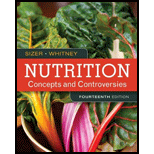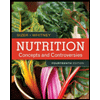
Nutrition: Concepts and Controversies - Standalone book (MindTap Course List)
14th Edition
ISBN: 9781305627994
Author: Frances Sizer, Ellie Whitney
Publisher: Brooks Cole
expand_more
expand_more
format_list_bulleted
Question
Chapter 14, Problem 2CT
Summary Introduction
To create:
A chart of nutrient-drug interaction and also describe how interactions affect absorption, excretion, and
Introduction:
Nutrient-drug interactions occur as a result of physical, chemical, and physiological relationships among the drugs and nutrients. Such interactions occur between the nutrients such as vitamins and minerals and medicines.
Expert Solution & Answer
Want to see the full answer?
Check out a sample textbook solution
Students have asked these similar questions
Have you ever encountered a situation in which you experienced (or had another person experience) a drug (OTC or prescription), herbal, or supplement-nutrient interaction? If so, explain what it was. If you have not, research a common interaction and explain it. Your explanation should include what drugs, herbs, or supplements and nutrient(s) are involved as well as the possible result of the interaction. Note that you are not to report on the side effects of a drug, herb or supplement, but rather how these might interact with a nutrient (in foods or in supplemental form) and result in a negative effect.
True/False
To increase the oral absorption of tetracyclines, they should be given with food or milk.
Macrolide antibiotics are classified as broad-spectrum bacteriostatic agents.
Penicillin is most effective against infections of gram-positive organisms, such as streptococci and staphylococci.
Opiates have a stimulating effect on the brain’s cerebral cortex.
Respiratory depression is the first sign of narcotic overdose.
Fill-in-the-Blank
Antibiotics that retard the growth of bacteria are called __________ agents.
Medications applied to the skin or into external body structures, such as the ear or eye, are commonly called ____________ agents.
Topical agents designed to be absorbed through the skin for systemic effects are commonly called ____________ medications.
Ophthalmic preparations…
Gastrointestinal (GI) disorders are relatively common and the GI system is where many drug side effects can occur. List and describe the action of one drug you or someone you know takes for gastrointestinal disorders.
Chapter 14 Solutions
Nutrition: Concepts and Controversies - Standalone book (MindTap Course List)
Ch. 14 - Prob. 1RQCh. 14 - Prob. 2RQCh. 14 - Prob. 3RQCh. 14 - Prob. 1CTCh. 14 - Prob. 2CTCh. 14 - Prob. 1SCCh. 14 - Prob. 2SCCh. 14 - Prob. 3SCCh. 14 - Prob. 4SCCh. 14 - Prob. 5SC
Ch. 14 - Prob. 6SCCh. 14 - Prob. 7SCCh. 14 - Prob. 8SCCh. 14 - Prob. 9SCCh. 14 - Prob. 10SCCh. 14 - Prob. 11SCCh. 14 - In research, which of the following is associated...Ch. 14 - Prob. 13SCCh. 14 - Prob. 14SCCh. 14 - Prob. 15SCCh. 14 - Prob. 16SCCh. 14 - The word DETERMINE is an acronym used in assessing...Ch. 14 - Prob. 18SCCh. 14 - Prob. 19SC
Knowledge Booster
Similar questions
- Select a patient problem (other than diabetes) that can be improved by a mobile application or technology. Describe the patient's problem.arrow_forwardIs alcohol good or bad for our health? To complete this discussion topic, please answer all three questions below 1.) In the US, how much alcohol is in one standard glass of wine, beer, and liquor? How are moderate and binge drinking defined? 2.) Alcohol is a nutrient and provides calories. Why are alcohol bottles exempted from having to include a nutrition facts label? Do you think alcohol should come with a nutrition facts label? Explain why or why not. 3.) If a friend asked you "Is alcohol good or bad for my health?" How would you respond? Provide at least one positive and negative consequence of alcohol consumption to substantiate your answearrow_forwardConsider the clinical, financial, psychological, and social ramifications of using home parenteral nutrition, with no foods allowed by mouth, in answering the following questions: What would be the advantages of living at home instead of in a hospital or other residential facility? Can you think of some disadvantages? Think about how you, as a patient, might manage daily infusions: consider the time, cost, and commitment required to maintain the therapy. If not allowed to consume food, what possible difficulties might you encounter? How would you handle holidays and special occasions that center around food?arrow_forward
- pick one option A nurse is planning nutritional instructions for a client experiencing fatigue due to iron deficiency anemia. Which of the following foods should the nurse recommend the client? 5 oz raisins 8 oz black tea 1 cup canned black beans 8 oz whole milkarrow_forwardYou are a nurse in an acute care hospital. Your new patient JD is in the hospital for fractures. His chart showed he has type 2 diabetes with HbA1c of 8.0%. JD’s sister came in to visit at lunch and brought him a Big Mac (3 slices of bread) with large fries on the side in addition to a bag of potato chips and a bottle of orange juice. You are concerned about the high carbohydrate content of the meal and discussed this with JD and JD’s sister. JD’s sister said, “I know my brother has diabetes, so I didn’t bring him soda or dessert.” JD said “I really love my carbs, but I know I should avoid all carbs to make my sugar low. Doctor said something about my ‘A1c’. Do you know what that is about?” Both JD and his sister said they would like to learn more about diabetes and diet.” Please explain to JD and his sister some of the diabetes treatment options, including diet, exercise, insulin injections, and oral medications. Please explain to JD’s sister the different types of carbohydrates.…arrow_forwardYou are a nurse in an acute care hospital. Your new patient JD is in the hospital for fractures. His chart showed he has type 2 diabetes with HbA1c of 8.0%. JD’s sister came in to visit at lunch and brought him a Big Mac (3 slices of bread) with large fries on the side in addition to a bag of potato chips and a bottle of orange juice. You are concerned about the high carbohydrate content of the meal and discussed this with JD and JD’s sister. JD’s sister said, “I know my brother has diabetes, so I didn’t bring him soda or dessert.” JD said “I really love my carbs, but I know I should avoid all carbs to make my sugar low. Doctor said something about my ‘A1c’. Do you know what that is about?” Both JD and his sister said they would like to learn more about diabetes and diet. Please explain to JD and his sister what the HbA1c test is and how to use A1c level to categorize normal blood sugar, pre-diabetes, and diabetes according to the ADA. Please also describe the target HbA1c level for…arrow_forward
- You are a nurse in an acute care hospital. Your new patient JD is in the hospital for fractures. His chart showed he has type 2 diabetes with HbA1c of 8.0%. JD’s sister came in to visit at lunch and brought him a Big Mac (3 slices of bread) with large fries on the side in addition to a bag of potato chips and a bottle of orange juice. You are concerned about the high carbohydrate content of the meal and discussed this with JD and JD’s sister. JD’s sister said, “I know my brother has diabetes, so I didn’t bring him soda or dessert.” JD said “I really love my carbs, but I know I should avoid all carbs to make my sugar low. Doctor said something about my ‘A1c’. Do you know what that is about?” Both JD and his sister said they would like to learn more about diabetes and diet. Please explain to JD why he needs carbohydrates and describe the 2 functions of carbohydrates. Please explain to JD’s sister the different types of carbohydrates. Provide 2 examples of simple carbohydrates and 2…arrow_forwardYou are a nurse in an acute care hospital. Your new patient JD is in the hospital for fractures. His chart showed he has type 2 diabetes with HbA1c of 8.0%. JD’s sister came in to visit at lunch and brought him a Big Mac (3 slices of bread) with large fries on the side in addition to a bag of potato chips and a bottle of orange juice. You are concerned about the high carbohydrate content of the meal and discussed this with JD and JD’s sister. JD’s sister said, “I know my brother has diabetes, so I didn’t bring him soda or dessert.” JD said “I really love my carbs, but I know I should avoid all carbs to make my sugar low. Doctor said something about my ‘A1c’. Do you know what that is about?” Both JD and his sister said they would like to learn more about diabetes and diet. Doctor said something about my ‘A1c’. Do you know what that is about?” ----- Can you Explain in detail what is A1c? Please explain to JD and his sister what the HbA1c test is and how to use A1c level to categorize…arrow_forwardPlan a one-day menu for a patient with hypertension, following the 2000 kcal. DASH Eating Plan and limiting sodium to 1500 mg. The DASH diet pattern is found in your textbook (Table 22-5) and on the 'Following the DASH Eating Plan' tab on the DASH website. Your menu should include: • specific foods with portion sizes • milligrams of sodium recorded for each food total grams of sodium for the day Reference the database used to look up sodium content of foods. USDA FoodData Central is recommended.arrow_forward
- choose one option only a nurse is providing dietary instructions to a client with diverticulitis about increasing fiber intake. Which of the following food choices by the client indicate the instructions has been understood? Eggs sweet potatoes milk pork sausagearrow_forwardAccording to the MyPlate recommendations, consumption of "empty calories" (as in soft drinks, sports drinks, sweet tea, or lemonade) is to be avoided. True Falsearrow_forwardUse the Mifflin–St. Jeor equation to calculate an appropriate energy intake for a 30-year old male hospital patient who is 5 ft 9 in. tall and weighs 162 lb. Use 1.25 as the stress factor for this patient. The patient’s energy requirement is _____ calories Blood antibody testing for food allergies ____. Group of answer choices is the most accurate method should be accompanied by other diagnostic tests to confirm the food allergy is rarely clinically meaningful predicts lack of allergy better than actual allergyarrow_forward
arrow_back_ios
SEE MORE QUESTIONS
arrow_forward_ios
Recommended textbooks for you
 Nutrition: Concepts and Controversies - Standalo...Health & NutritionISBN:9781305627994Author:Frances Sizer, Ellie WhitneyPublisher:Brooks Cole
Nutrition: Concepts and Controversies - Standalo...Health & NutritionISBN:9781305627994Author:Frances Sizer, Ellie WhitneyPublisher:Brooks Cole- Essentials of Pharmacology for Health ProfessionsNursingISBN:9781305441620Author:WOODROWPublisher:Cengage
 NutritionHealth & NutritionISBN:9781337906371Author:Sizer, Frances Sienkiewicz., WHITNEY, ElliePublisher:Cengage Learning,
NutritionHealth & NutritionISBN:9781337906371Author:Sizer, Frances Sienkiewicz., WHITNEY, ElliePublisher:Cengage Learning,

Nutrition: Concepts and Controversies - Standalo...
Health & Nutrition
ISBN:9781305627994
Author:Frances Sizer, Ellie Whitney
Publisher:Brooks Cole



Essentials of Pharmacology for Health Professions
Nursing
ISBN:9781305441620
Author:WOODROW
Publisher:Cengage

Nutrition
Health & Nutrition
ISBN:9781337906371
Author:Sizer, Frances Sienkiewicz., WHITNEY, Ellie
Publisher:Cengage Learning,